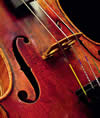
FILM #13: SUSTAINED AND DÉTACHÉ BOWING (book chapter 16)
OVERVIEW: Part I demonstrates how slow bow strokes and a firm tone can be developed. The actual vibrations of the string in slow motion are shown. The development of bow pressure and correct bow distribution are demonstrated. In Part II, détaché bowing and its variants are explained and demonstrated. The performers are of all age levels.
Part I: Sustained Strokes
1. Sustained strokes; string vibrations from an evenly drawn bow and change of direction shown in slow motion; drawing the bow near the bridge for slow strokes; drawing the bow evenly when playing four-count and three-count strokes; a common fault of beginners when changing bows at the tip
2. Playing scales with slow strokes to develop an even, full tone; develop a firmer string contact by pulsating the bow pressure; by pulling against a resistance playing double stops and portato bowings to develop a full tone
Part II: Détaché and Related Bowings
1. Détaché bowing (faster, singing tones combined with single bow strokes) of various types: expressive, simple and without accents, the col legno stroke (détaché stroke with harmonics), accented, combined with martelé
2. Balancing the arm and coordinating the upper arm and forearm for a good détaché stroke; demonstrations by Paul Rolland and students of détaché bowing at various speeds and with different articulations
3. Sautillé bowing (bouncing fast short détaché strokes); playing near the bridge
for the thin hissing sound of the sul ponticello, and near the fingerboard for the
mellow tone of the sul tasto; tremolo; slurred staccato, or tremolo-staccato;
demonstration of détaché and sautillé bowings in the “Banjo Tune”